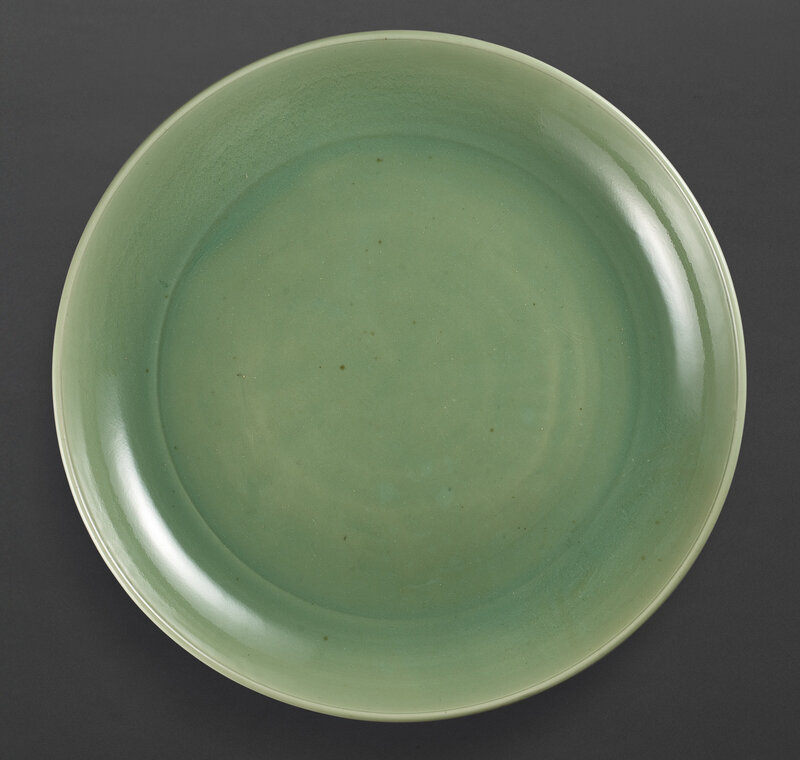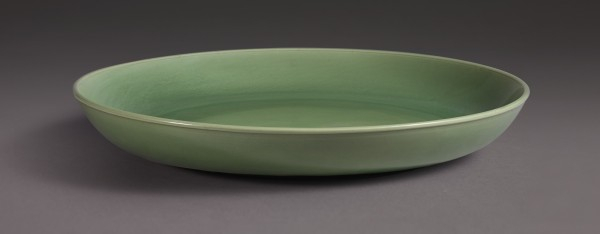A massive Longquan celadon charger, Ming dynasty, 15th century


Lot 3007. A massive Longquan celadon charger, Ming dynasty, 15th century; 63.5 cm, 25 in. Estimate 2,200,000 — 2,800,000 HKD (280,478 - 356,972 USD). Lot Sold 3,250,000 HKD (413,823 USD). Courtesy Sotheby's.
robustly potted with rounded sides rising from a tapered foot to a lipped rim, covered overall in an attractive sage-green glaze, save for a broad ring at the base fired to burnt orange.
Provenance: Collection of Charlotte Horstmann (1908-2003).
Christie’s Hong Kong, 26th September 1989, lot 555
Dishes of this size are rare and only a small number of related examples is known: a reconstructed dish excavated at the imperial Longquan kilns at Chuzhou, Zhejiang province, is illustrated in Ye Yingting and Hua Yunong, Faxian. Da Ming Chuzhou Longquan guanyao [Discovery. Imperial ware of the great Ming dynasty from Longquan in Chuzhou], Hangzhou, 2005, pl. 6; one was sold in these rooms, 5th October 2016, lot 3639; a slightly larger one in the Idemitsu Museum of Arts, Tokyo, was included in the Museum’s exhibition Gen Min no tōji [Yuan and Ming ceramics], Tokyo, 1977, cat. no. 157; and another from the collection of Cargill and Donna MacMillan, was sold in our New York rooms, 8th May 1981, lot 254, and again at Christie’s New York, 26th March 2010, lot 1356.
Large chargers were made at the Longquan kilns from as early as the Yuan dynasty (1279-1368), and were designed predominantly for export. In the early Ming dynasty, such vessels played an important role in the formation of tributary relations between the Ming imperial court and foreign powers. Large chargers were uniquely adapted to Middle Eastern dining customs, and a significant number of chargers is in the collection of the Ottoman Sultans, now preserved in the Topkapi Saray Museum, Istanbul. A miniature depicting their use at a feast held in Topkapi Saray, Istanbul, in the 17th century is illustrated in Regina Krahl, Chinese ceramics in the Topkapi Saray Museum, Istanbul, ed. John Ayers, London, 1986, vol. 1, p. 45.

/https%3A%2F%2Fprofilepics.canalblog.com%2Fprofilepics%2F1%2F0%2F100183.jpg)
/https%3A%2F%2Fstorage.canalblog.com%2F03%2F02%2F119589%2F96711876_o.jpg)
/https%3A%2F%2Fstorage.canalblog.com%2F11%2F31%2F119589%2F94773502_o.jpg)
/https%3A%2F%2Fstorage.canalblog.com%2F20%2F83%2F119589%2F94772815_o.jpg)
/https%3A%2F%2Fstorage.canalblog.com%2F26%2F72%2F119589%2F75604929_o.jpg)
/https%3A%2F%2Fstorage.canalblog.com%2F59%2F60%2F119589%2F26458628_o.jpg)


/http%3A%2F%2Fstorage.canalblog.com%2F76%2F15%2F119589%2F129393400_o.jpg)
/http%3A%2F%2Fstorage.canalblog.com%2F70%2F68%2F119589%2F129131712_o.jpg)
/http%3A%2F%2Fstorage.canalblog.com%2F13%2F69%2F119589%2F129078661_o.jpg)
/http%3A%2F%2Fstorage.canalblog.com%2F93%2F01%2F119589%2F129030904_o.jpg)